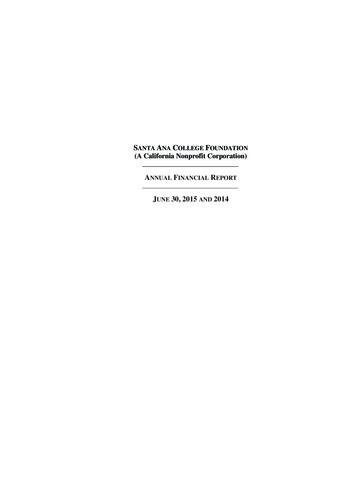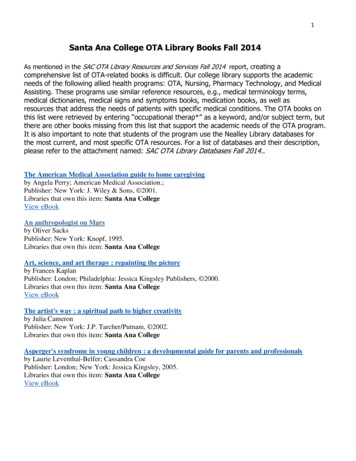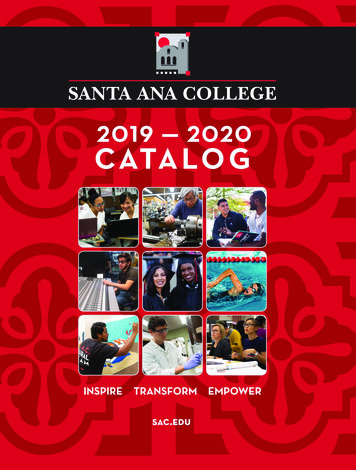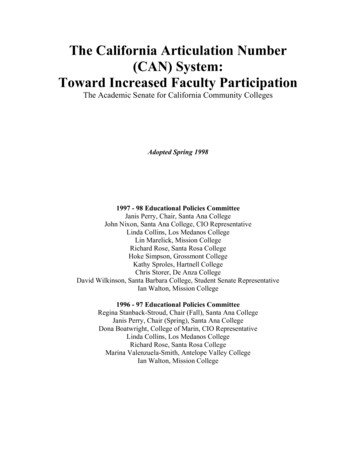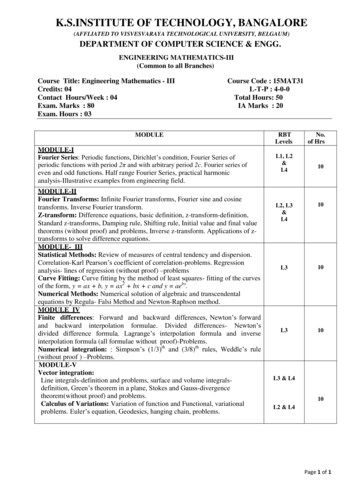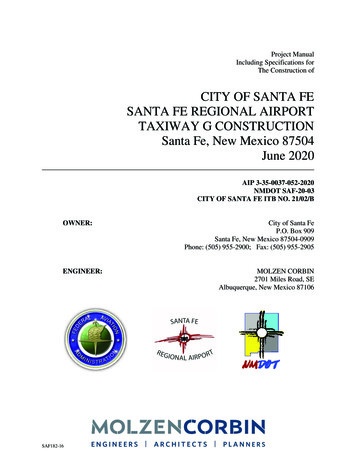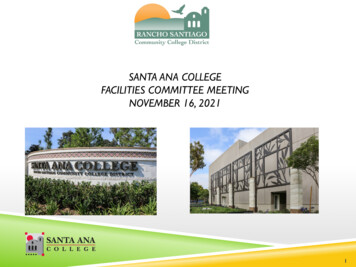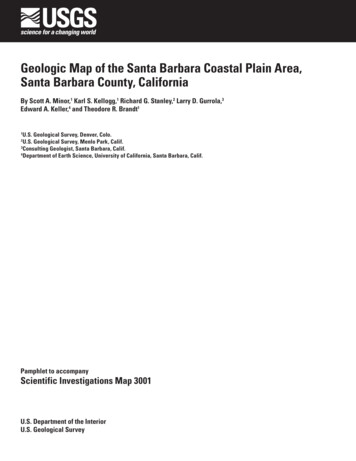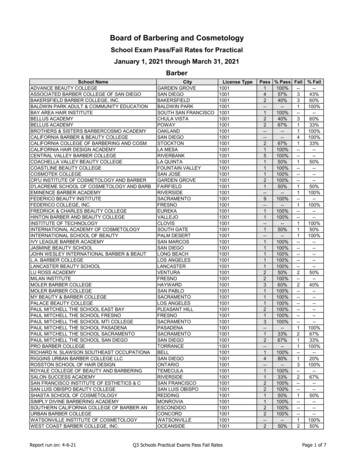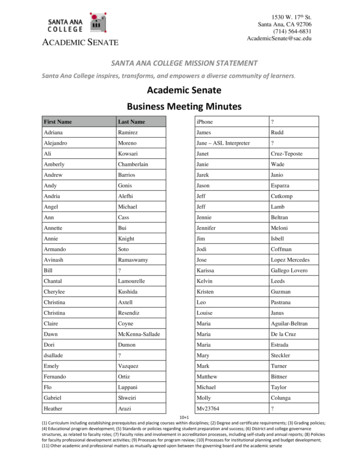
Transcription
1530 W. 17th St.Santa Ana, CA 92706(714) 564-6831AcademicSenate@sac.eduACADEMIC SENATESANTA ANA COLLEGE MISSION STATEMENTSanta Ana College inspires, transforms, and empowers a diverse community of learners.Academic SenateBusiness Meeting MinutesFirst NameLast ane – ASL swamyJoseLopez MercedesBill?KarissaGallego nMcKenna-SalladeMariaDe la rAraziMv23764?10 1(1) Curriculum including establishing prerequisites and placing courses within disciplines; (2) Degree and certificate requirements; (3) Grading policies;(4) Educational program development; (5) Standards or policies regarding student preparation and success; (6) District and college governancestructures, as related to faculty roles; (7) Faculty roles and involvement in accreditation processes, including self-study and annual reports; (8) Policiesfor faculty professional development activities; (9) Processes for program review; (10) Processes for institutional planning and budget development;(11) Other academic and professional matters as mutually agreed upon between the governing board and the academic senate
ondDate:Tuesday, Oct 26, 2021Time:1:30-3:30pmLocation:Zoom Webinar LocationMeeting Location: For security purposes, please access the Zoom link using this Microsoft Formslink https://forms.office.com/r/uws9ARqek81. Call to Order – Jim Isbella. Meeting was called to order at 1:33pm.2. Approval of Additions or Corrections to Agendaa. No additions or corrections3. Approval of/or Corrections to Minutesa. Jim Isbell pointed out that Claire Coyne’s last name was misspelled once and that theminutes had October 28th listed a handful of times as the next Academic SenateBusiness Meeting as opposed to October 26th.b. Reza Mirbeik made the first motion to approve the minutes.c. Zachary Diamond made the second motion to approve the minutes.4. Public Comments10 1(1) Curriculum including establishing prerequisites and placing courses within disciplines; (2) Degree and certificate requirements; (3) Grading policies;(4) Educational program development; (5) Standards or policies regarding student preparation and success; (6) District and college governancestructures, as related to faculty roles; (7) Faculty roles and involvement in accreditation processes, including self-study and annual reports; (8) Policiesfor faculty professional development activities; (9) Processes for program review; (10) Processes for institutional planning and budget development;(11) Other academic and professional matters as mutually agreed upon between the governing board and the academic senate
a. Ali Kowsari shared the following recent activity from the Business Division: The Legal Department collaborated with the School of Continuing Educationto provide a citizenship resources virtual fair. Bridge to Engineering program had 15 students tour Glidewell in Irvine. Theyare also hosting a two-session workshop starting Friday, Oct 29th called“Transforming Your Mindset.”b. Reza Mirbiek asked if the equivalency form that is uploaded on the district website iscurrent and the latest version?c. Jim Isbell commented that as he understands it, the equivalency form that isuploaded on the website is the most recent one. There’s work being done at themoment to review it.d. Amberly Chamberlain shared that the Theater Arts Department is struggling ingetting approval for instructional supplies like food for their productions. Food isused as props on stage during performances. Consequently, they are trying to findoutside funds to pay for these types of instructional supplies.e. Chantal Lamourelle said that the Child Development Department is interested inbeing considered as the next bachelor’s degree program offered at SAC.5. Reportsa. ASG Report — Jason Esparza Jason shared that this Thursday, October 28 is the Fiesta de Freight event. It’sa Halloween event that is comprised of three activities: (1) pumpkin carvingcontest; (2) food, games, etc. in the campus plaza; and (3) movie screening ofDisney’s Coco from 5:30-7:15pm. Campus plaza activities and pumpkincarving will be from 12:30-2pm. He also shared that they are in the process of finalizing Native HeritageMonth which will take place next month. A Veteran’s Day event will also beheld next month. Kristen Guzman pointed out that it seems like the Halloween event isoverlapping with Día de los Muertos which are two holidays with two
different meanings. Jason replied that ASG’s intention was to include amixture of Halloween and Día de los Muertos which is why it’s called Fiesta deFreight. They wanted both holidays to be acknowledged and celebrated.b. SCC Report — Professor Tara Kubicka-Miller Tara reported that SCC submitted a resolution that will align enrollment dateswith surrounding districts. They hope this leads to increase enrollments.6. Equity and Guided Pathways – Prof. Maria Aguilar Beltran & Prof. Stephanie Clark (5Minutes)a. Stephanie reported that they still have implementation teams for Guided Pathways.They have less teams now that than they used to. Their Entry Team is lead Alicia Kruizenga and Armando Soto. They haveprioritized a better and stronger integration of the Super Strong Assessmentinto the onboarding process and especially with high school and early decisionstudents. They're also focusing on identifying and developing a bettercommon math placement tool. This will help outreach better serve studentsregarding their math placement for the first year which has been a barrier.Typically, students are asked to see a counselor to enroll in math but theytypically don't enroll. She reminded everyone that all programs have Success Teams related to theirCAPs. These teams involve coordinators, faculty leads, and counselors. Achange this year is there are student ambassadors on each success team thatwill help with bringing in that student voice. In addition, they have successcoaches that play an integral part in the implementation of Starfish. Whenacademic flags are raised by faculty in Starfish, success coaches will bereaching out to those students. The ideal timeline is to connect with thestudent within 24 hours of a flag being raised in Starfish. They will reach outto a student for a total of three times and will close the flag after the thirdattempt if they don’t hear back from the student. Finally, if faculty don’t knowwho is their faculty lead, Stephanie asked to connect with her.1. Ali Kowsari asked if there a mechanism where if a Success Teammember doesn’t get a response from a student after the third time,will they connect with the faculty lead? Or if after the third time, theacademic flag is considered closed? Stephanie answered that it’s herunderstanding that flags are closed after three attempts of trying to10 1(1) Curriculum including establishing prerequisites and placing courses within disciplines; (2) Degree and certificate requirements; (3) Grading policies;(4) Educational program development; (5) Standards or policies regarding student preparation and success; (6) District and college governancestructures, as related to faculty roles; (7) Faculty roles and involvement in accreditation processes, including self-study and annual reports; (8) Policiesfor faculty professional development activities; (9) Processes for program review; (10) Processes for institutional planning and budget development;(11) Other academic and professional matters as mutually agreed upon between the governing board and the academic senate
connect with a student. She added that if faculty want that in place,success coaches can be asked to type notes in Starfish. Therefore, thequestion is if faculty want that? What the Success Team doesn't wantis to have many flags raised and not addressed in some manner. Shesaid that a conversation about Success Team members workflow canbe had that would benefit everyone. Stephanie also mentioned thatthe Starfish Team did talk about on how to message students andprovide the resources in the email. This way, if students need support,they have the opportunity to get it themselves because they may notfeel comfortable calling a success coach back or emailing them back ifthey don't know them. In the message, they are embedding links andresources, and more context for why students would use eachresource. Learning and Engagement Team has been slowly showing people a newconcept for a four-year Faculty Institute. They plan to conduct a presentationon the framework at possibly the next Academic Senate Business Meeting.Currently, different committees are reviewing it.b. They met with SCC Guided Pathway Coordinators. The plan is to collaborate moreand identify common problems so it can be brought to the district’s attention and amore integrated support can be provided district wide. They have a district meetingtomorrow in which they will initiate these conversations. A few areas have alreadybeen identified which center around professional development in Guided Pathwaysand equity, as well as using Canvas shells.7. ILOs Second Reading (10 minutes) – Dr. Jarek Janio Action Itema. Dr. Janio informed attendees that the question from the last Academic Senatemeeting regarding reading not being included as an ILO under the communicationskills heading was addressed with the Outcomes Assessment Committee. As aresult, they came up with the following: “Students, will be able to effectively readcollege materials to identify, and employ concepts.” This ILO is now includedunder communication skills. He reiterated that it had been some time since ILOshad been updated so the committee took great pride in completing this work.b. Christian Axtell made the first motion to approve the ILOs.c. Susan Hoang made the second motion to approve the ILOs.d. Voting results: 36 yes, 0 no, & 0 abstentions. Motion passes.8. Assessment Center Update—Dr. Armando Sotoa. Jim Isbell provided background information on why the Assessment Centerwas presenting. In short, within the last month, a couple of individuals
made a public comment about issues that faculty and students were havingwith connecting and accessing services from the Assessment Center.Consequently, Dr Soto and his team will be providing an update andeducate Senate on why it operates the way it does and how currentproblems people are experiencing be resolved.b. Dr. Soto, Associate Dean of Counseling, stated that he and his team will beaddressing the concerns that were raised, specifically, on September 14thand the 28th by nursing faculty during public comment. He added that heand his team also met with Mary Steckler, nursing dean, on October 18th,and they were able to talk through the concerns and develop a plan.Nonetheless, he reviewed the following concerns that were addressed lastmonth during public comment: On one occasion, a faculty member had confirmed dates and examtimes for DSPS students, only to find there was no one at theAssessment Center at the time of the exam.1. The Assessment Center will post the schedule changes ontheir website. Faculty can plan accordingly and faculty whohave a scheduled appointment will be notified via email ofscheduling changes.2. The current process is for students to visit the center’swebsite and fill out a form which identifies theiraccommodation. When students submit the form, theyschedule an appointment and will receive an emailconfirmation. The nursing faculty has requested to becontacted as well, so center staff will ensure that response isgiven.3. If there's a last-minute center closure, an off-campus emailwill be sent to ensure that the campus community is aware.Unfortunately, this wasn’t done recently. One of the main10 1(1) Curriculum including establishing prerequisites and placing courses within disciplines; (2) Degree and certificate requirements; (3) Grading policies;(4) Educational program development; (5) Standards or policies regarding student preparation and success; (6) District and college governancestructures, as related to faculty roles; (7) Faculty roles and involvement in accreditation processes, including self-study and annual reports; (8) Policiesfor faculty professional development activities; (9) Processes for program review; (10) Processes for institutional planning and budget development;(11) Other academic and professional matters as mutually agreed upon between the governing board and the academic senate
issues the center is experiencing is staff shortage due toretirement. They have lost 75% of their staff. This includestheir DSPS specialist who resigned on August 12th whichmade it for a challenging start to the fall semester. Currently,they have two full-time staff and one part-time. On thespecific date when the center was closed and no email wassent to the campus community, two staff were scheduled towork that day. One of them was at Segerstrom High Schooladministering the Super Strong Assessment to over 400students. There was a one-hour overlap at 2pm where thisperson was to return but the other staff member called insick. As a result, there was no coverage at the center duringthat time period. Students who had an appointment at thecenter were rescheduled. Furthermore, staff is responsiblefor registration, orientation, and scheduling students. Thesessions are two-hours and take place three times a week.They're also responsible for student placement in terms ofEnglish, math, and MLS/ESL. For students that don't havehigh school transcripts, they're responsible for administeringthe guidance of placement. The other concern that was raised is that students are not beingprovided their legal rights to appropriate accommodations.1. Currently, there hasn’t been a formal student complaint thattheir rights have been violated. Thus, the center is incompliance with state regulations, and they are beingcareful and monitoring this. They are providing reasonableacademic accommodations required for students withdisabilities and remain in compliance with state regulations.2. The center is open to proctor the required five hours forstudents that require double time and or time and a half, ora final test examination for their finals. As it pertains toproviding a distraction free environment, it does not
necessarily mean it will be at the Assessment Center or in aprivate room. A distraction free area could be in theclassroom such as sitting a student in the front or rear of theclassroom. It could also be in the library with minimal or nodistractions. In short, the goal is distraction free withinreasonable accommodations for the student.a. Dr. Veronica Oforlea, DSPS Associate Dean, thankedfaculty for their continue support of students,especially as it pertains to the accommodations listedon student letters. She introduced Mark Turner andLouise Janus, who are DSPS faculty, to further speakon this matter.b. Mark Turner shared that due to the suddentransition to remote instruction, DSPS hasundertaken a variety of projects to provide newaccommodations and to reorient the way that certainexisting accommodations are provided. Theyregularly consult not only with departments, but withindividual faculty on universal design considerations.Their primary goal when communicating with faculty,regarding accommodations, is to ensure that they areas clear and specific as can be, while at the sametime indicating that in many cases there are varietyof options. Options that address the uniquecharacteristics of faculty schedules, students’schedules, and the particular functional limitations ofa student. Historically, faculty have relied heavily onthe Assessment Center for that distraction reducedenvironment. Currently, though, until a full10 1(1) Curriculum including establishing prerequisites and placing courses within disciplines; (2) Degree and certificate requirements; (3) Grading policies;(4) Educational program development; (5) Standards or policies regarding student preparation and success; (6) District and college governancestructures, as related to faculty roles; (7) Faculty roles and involvement in accreditation processes, including self-study and annual reports; (8) Policiesfor faculty professional development activities; (9) Processes for program review; (10) Processes for institutional planning and budget development;(11) Other academic and professional matters as mutually agreed upon between the governing board and the academic senate
proctoring schedule is restored, everyone has to bemore flexible and creative at times in identifying arange of locations that meet a student’saccommodations. DSPS also realized that historically,because they and faculty have heavily relied on theAssessment Center to deliver that service, DSPS hadnot been providing very granular recommendationswith respect to what would constitute an acceptabledistraction reduced environment. Thus, that led todiscussions which resulted in preparingdocumentation that's going live on the DSPS websitethat speaks to the issue of distraction reducedenvironments. There will be a link to that new pageon the accommodation letter template. Furthermore,he clarified between the two distinct factors when itcomes to accommodations which is location andcharacteristics of the location. In the past, there wastwo options: a location that was determined incollaboration with the instructor and the AssessmentCenter. Whether a distraction reduced environmentis included in a student’s letter is specific to thatstudent and it is completely separate from theconcept of whether the Assessment Center will bethe designated location. Students are only qualifiedfor reduced distraction environment, to the extentthat they have a disability specific functionallimitation that require it. That's a subset of peoplewho are eligible for testing accommodations and it'stailored under ADA to a student’s specific functionallimitations. In sum, there are two distinct groups ofstudents, those who specifically needed a distraction
reduce environment and those that don't but mayrequire other testing accommodations.c. Louise Janus explained that accommodations relatedto a distraction reduced environment, certaininformation will be included on the accommodationletter, so faculty know if a student requires adistraction reduced environment. This doesn’tnecessarily mean that location is the AssessmentCenter. Therefore, the recommended language thatDSPS is using to change on their accommodationletters, is that the Assessment Center or a reasonablealternative, for example, Nealy Library, AcademicComputing Center or other centers. Another optionand language that will be included is instructorcoordinated location which could include a classroomoffice, lab space, conference room, or online. On theaccommodation letter, the left side has classroomaccommodations and on the right side it has testingaccommodations. She clarified that a reductionreduced environment is not a reduction freeenvironment. On the DSPS webpage, there isinformation listed for consideration in all classmodalities.i. Susan Hoang commented that that librarycan't guarantee a distraction reduceenvironment. It depends on where studentsare sitting. Consequently, she cautions facultywho might send their students to the librarybecause they think it’s a guaranteed10 1(1) Curriculum including establishing prerequisites and placing courses within disciplines; (2) Degree and certificate requirements; (3) Grading policies;(4) Educational program development; (5) Standards or policies regarding student preparation and success; (6) District and college governancestructures, as related to faculty roles; (7) Faculty roles and involvement in accreditation processes, including self-study and annual reports; (8) Policiesfor faculty professional development activities; (9) Processes for program review; (10) Processes for institutional planning and budget development;(11) Other academic and professional matters as mutually agreed upon between the governing board and the academic senate
reduction reduced environment orcompletely silent. Also, there are four groupstudy rooms, and the library must keep themas such because they are in high demand.ii. Quynh Mayer shared that she once referredstudents to the Academic Computing Center,and they said it was louder than their noisyapartment.iii. Jim Isbell asked what is the average timebetween students completing the online formwith their contact info and gettingappointments to take an exam? Dr. Sotoanswered it’s a 5-day window but typically it’the same day because staff is monitoring theforms being submitted.d. Dr. Oforlea emphasized that if a faculty member hasa student who is asking for something they believe isunreasonable, to please contact the DSPS Office sothey can handle the situation. DSPS’ goal is to ensurefaculty can focus on teaching and they will do theirpart, which is disability services.c. Dr. Jeff Lamb asked if students are supervised while taking exams? Markreplied that it’s not always the case. For instance, students take exam insynchronize Zoom environment.d. Roy Shahbazian asked if it’s a requirement for students to provide theirbirthdate when scheduling an appointment? Dr. Soto answered that it’snot a requirement. It’s the student ID number they need to have.e. Dr. Soto addressed the concern of faculty not having the time to: keep upevery week with following up and reaching no solution; spend extra time inensuring there is faculty available to sit during the time with the student;and arrange the time and mode/space that is recommend for the student.The Assessment Center response to these concerns is the following:
Instructors were trained to use either Proctorio or Examplify whichwill support instructors in making the necessary time adjustmentsfor students with such accommodations. Options: Instructors could proctor the exam themselves, coordinatewith their division secretary to identify an available classroom toproctor the exam or seek space via the Assessment Center. The Assessment Center will provide make up tests for students thatdo not require an accommodation for their disability.1. Assessment Center Make-Up Testing & AccommodationHours Schedulea. Tuesday 9am-2pmb. Thursday 2pm-7pmc. Friday 8am-10amd. Appointments are in-person for students with anaccommodation.e. Students must begin their make-up session 1 hourbefore closing.f. Students are to schedule this appointment 5 days inadvance. They are to schedule it on the DSPSwebsite.f. Mary Steckler asked for exams that require to be proctored, like thosegiven in the nursing program, who will be proctoring these exams forstudents who have accommodations? Dr. Oforlea answered that forstudents who make-up exams on Fridays, they are monitored at theAssessment Center. Mary responded that’s only on Fridays at theAssessment Center so a discussion needs to be had on what can be done atother locations like the library, computer lab, etc. Dr. Soto agreed withMary and emphasized the importance of addressing this need.10 1(1) Curriculum including establishing prerequisites and placing courses within disciplines; (2) Degree and certificate requirements; (3) Grading policies;(4) Educational program development; (5) Standards or policies regarding student preparation and success; (6) District and college governancestructures, as related to faculty roles; (7) Faculty roles and involvement in accreditation processes, including self-study and annual reports; (8) Policiesfor faculty professional development activities; (9) Processes for program review; (10) Processes for institutional planning and budget development;(11) Other academic and professional matters as mutually agreed upon between the governing board and the academic senate
g. Dr. William Nguyen commented that the college, needs to do advanceplanning for spring 2022 considering more in-person classes will be offeredwhich will result in more students needing to take make-up exams inperson. More staff is what the Assessment Center needs in order to meetthis expected increase in demand.h. Mark stated that at the end of the day, the Civil Rights Office doesn't lookat the budget of the Assessment Center, DSPS, or the entire campus butrather, the budget of the district and they ask how 1% of the allocationfrom the top level of the district is a fundamental hardship for solving anissue? At that point, they can start imposing mandates, such as imposing adean of compliance. Therefore, he urges for continued progress betweennow and spring 2022, because if they don't have a proportionate increasein the availability of support with proctoring, not only for the needs ofnursing, but all the other departments, they will be in serious jeopardy forcomplaints. Stephanie Clark added that digital proctoring is available to allfaculty. Thus, the proctoring issue could be resolved through somedifferent tools that are available and more creative thinking aroundexams. Overall, faculty needs to meet student needs because that'severyone's responsibility, not just the Assessment Centers.6.Equity and the Classroom: Masks and Testing—Prof. James (Marty) Rudda.Marty shared that eventually the college will return to a point wear masksare not mandated in the classroom. As a result, he wants to get theconversation started about having a plan, especially because certaindepartments don't really need to wear masks at this point. He has studentsask him on why they need to wear mask if they have received both theirvaccine doses and get tested weekly. In short, this is a topic of conversationbecause there’s isn’t consistency across the campus, as it applies to thestudent population, on who wears masks. He recommends looking at howindustries are conducting business and have department match thosestandards.
1.Kelvin Leeds commented that areas, like athletics, don’t wearmasks because they must adhere to strict testing.2.Flo Luppani shared that yes, student athletes, staff, and coachesget tested weekly. They also get tested 72 hours before anycompetition. Student athletes must have a negative test on handand if they don't, they're not cleared to participate. Everyonemust wear a mask for indoor events except for the athletes whoare playing. Students and faculty wear mask for kinesiologylectures and activity classes that are indoors.3.Amberly Chamberlain informed the group that the PerformingArts Department advocated for similar type standards thatathletics abide by. They recently got approved and thus, will begintesting so students who are performing on stage can beunmasked. She feels it's important that the college moves forwardunderstanding what works for one department will not necessarilywork for another department. Therefore, it’s important to notewhat's happening in industries so it can reflect what departmentsare doing and that being approved by administration7.Distance Education: Updates/Training Informational—Prof. Cherylee Kushidaa.Cherylee listed the different online teaching modalities: fully online(asynchronous), fully online live (synchronous Zoom), hybrid with oncampus instruction and asynchronous work, and virtual hybrid(synchronous Zoom and asynchronous work). Currently, in draft mode, isanother modality which is on-campus virtual. This is a course that would besynchronous when on-campus and using Zoom virtually. Since differentdepartments were running this modality, the DE Advisory Committeewanted to accommodate for this. It’s in draft form because Dr. Lamb is inprogress of obtaining an agreement with SCC in terms of the actual namefor this modality. Nonetheless, this modality will be available and offered10 1(1) Curriculum including establishing prerequisites and placing courses within disciplines; (2) Degree and certificate requirements; (3) Grading policies;(4) Educational program development; (5) Standards or policies regarding student preparation and success; (6) District and college governancestructures, as related to faculty roles; (7) Faculty roles and involvement in accreditation processes, including self-study and annual reports; (8) Policiesfor faculty professional development activities; (9) Processes for program review; (10) Processes for institutional planning and budget development;(11) Other academic and professional matters as mutually agreed upon between the governing board and the academic senate
during spring 2022. Teaching in this modality, like fully online live, will becovered by the FARSCCD MOU. As a result, the Remote InstructionCertification (RIC) would suffice to teach it in spring 2022 because it’s fullysynchronous.b.Regarding online teaching training, there’s been a lot of conversation aboutthe MOU covering faculty to use the RIC for spring and summer 2022 tocontinue teaching fully online live. Planning ahead for fall 2022, the DEAdvisory Committee recognizes that all synchronous and asynchronouscourses are on Canvas so all grades, assignments, communication, etc. aredelivered in Canvas. It also provides students the equity of 24/7 access toall of their course materials. SAC is a consortium member of the CVC(California Virtual Campus). SAC is required to use a quality format toincrease the quality of online courses by June of 2023. They have started todo that and use the CCC online course desig
SANTA ANA COLLEGE MISSION STATEMENT. Santa Ana College inspires, transforms, and empowers a diverse community of learners. Academic Senate . Business Meeting Minutes . First Name Last Name Adriana Ramirez Alejandro Moreno Ali Kowsari Amberly Chamberlain Andrew Barrios Andy Gonis Andria Alefhi Angel Michael Ann Cass Annette Bui Annie Knight
